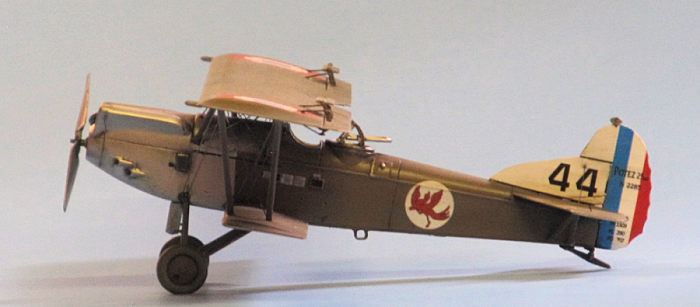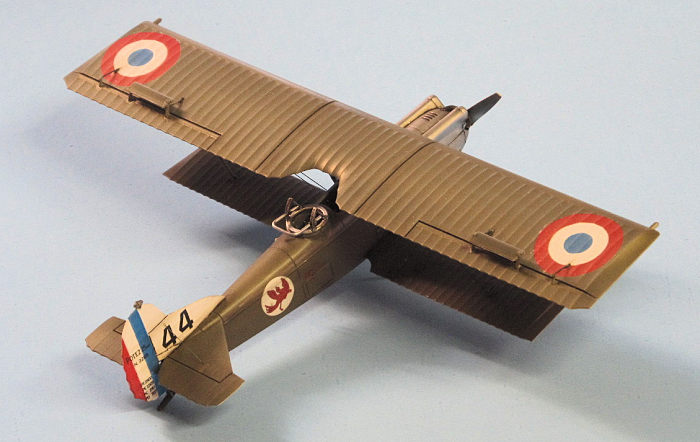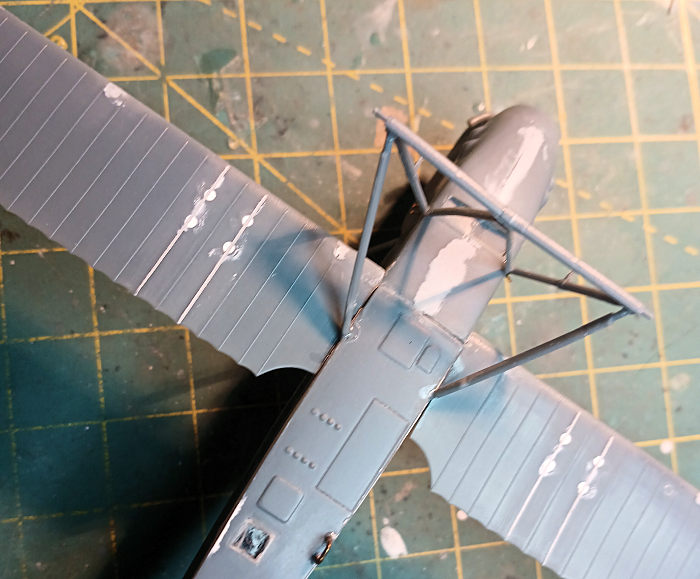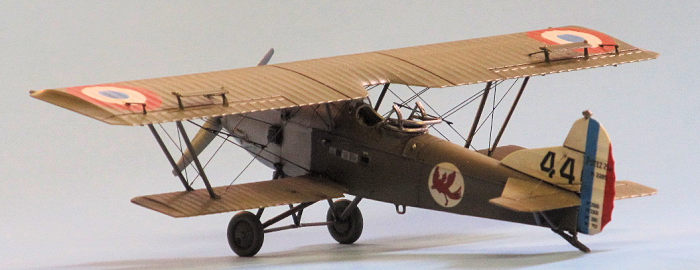
| KIT #: | FR0053 |
| PRICE: | $ |
| DECALS: | Three options |
| REVIEWER: | Ryan Grosswiler |
| NOTES: | Limited run kit with photo etch and 3D parts. |

| HISTORY |
 If
you'd asked me before I started this project about the Potez 25, the statement,
"it was a really popular airplane during the interwar period. A bunch of nations
used it!" would have exhausted my knowledge.
If
you'd asked me before I started this project about the Potez 25, the statement,
"it was a really popular airplane during the interwar period. A bunch of nations
used it!" would have exhausted my knowledge.
Besides its general usefulness in concept, pleasant flying characteristics, and rugged construction, the genius of the design is that the front end could be adapted to mount a wide variety of powerplants. This meant that the aircraft appealed to a variety of nations and their available resources; at least six different engines would end up in production installation on the aircraft and there would also be three different vertical tails, two different landing gear, and dozens of detail differences.
With over 4000 built and export or license to fifteen nations, the aircraft would see action all over the world. I cannot in this space provide a comprehensive overview, but here is a sampling:
Ethiopia: via a Belgian exporter, 3 aircraft were delivered initially as unarmed communications aircraft. Ordered by Emperor Haile and named after himself and his two sons, they were used to tie the vast distances between settlements in the nation into a more unified network of familiarity. 3 more would be delivered later, and the type was used for reconnaissance during the Italian invasion of the country.
Paraguay: the eventual 15 aircraft acquired by the country were used extensively in the Chaco War against Bolivia, not only as light bombers but also innovatively radio-directing artillery fire. The Bolivians, for their part, responded with air power of their own and downed at least one in what was the first hostile air-to-air engagement over the Americas.
 China/Japan:
Japan purchased a
single example for evaluation at the end of the 1920s, but did not order any
further. However, Marshall Zhoulin's Manchurian government had purchased about
25. When Mukden airfield was overrun by the Japanese in September 1931 these
were seized by the Japanese and pressed into front-line service.
China/Japan:
Japan purchased a
single example for evaluation at the end of the 1920s, but did not order any
further. However, Marshall Zhoulin's Manchurian government had purchased about
25. When Mukden airfield was overrun by the Japanese in September 1931 these
were seized by the Japanese and pressed into front-line service.
The type would go on to serve in World War II proper. With at least 100 still in service in both Greek and Yugoslav air forces, these would be thrown into the desperate fight not only for reconnaissance but light attack. The Greeks used theirs with particular effectiveness in close air support, and according to one British account actually managed to shoot down a German Hs-126. However, probably the most decisive single action in this theatre by the old Potez would be for the enemy: on the night of 3 April, with the German invasion imminent, a Yugoslav Major Vladimir Kren defected to Graz, taking with him a full set of code and cipher books and locations of his former service's dispersal airfields. As all this had to be changed in a hurry, the act threw the Yugoslav Air Force into an unhelpful moment of disarray at a critical moment.
Back to France, the aircraft's country of origin. While by September 1939 the Potez 25 had been relegated to second-line service in metropolitan France, it remained very much at the front in the country's overseas territories. Replete in red-and-yellow Vichy "Slave Stripes", they were present in numbers in the Levant to resist Allied action in the region during 1941. Across the Eurasian landmass, they saw combat in the brief but intense fight against the Thais the same year, completing two decades of service in Southeast Asia when replaced by more modern aircraft in 1945.
| THE KIT |
 The Potez
25 has been covered previously in all media, but the Azur family of kits is the
most comprehensive in representing all variants. I think this is the sixth or
seventh release
of this kit. Half a dozen sprues and a sheet of photoetch contain the parts. A,
B, C, D, and the clear one seem to be common among all of them, with additional
sprue (in this case 'K') to account for the differences in engine, forward
fuselage, and other equipment from variant to variant. The package is rounded
out with a nice set of decals and an instruction booklet, plus one very nice
3D-printed propeller in orange resin.
The Potez
25 has been covered previously in all media, but the Azur family of kits is the
most comprehensive in representing all variants. I think this is the sixth or
seventh release
of this kit. Half a dozen sprues and a sheet of photoetch contain the parts. A,
B, C, D, and the clear one seem to be common among all of them, with additional
sprue (in this case 'K') to account for the differences in engine, forward
fuselage, and other equipment from variant to variant. The package is rounded
out with a nice set of decals and an instruction booklet, plus one very nice
3D-printed propeller in orange resin.
Decals represent three peacetime aircraft from the mid-30s, all in overall French Verde Fonce with natural metal cowlings. The photoetch parts include rigging anchors...thoughtful, yes, but some of them are really, really puny. We'll see how I do with them! A tiny errata sheet in the bag advises that the second decal option—the one I wanted to do—used the Messier-type landing gear. The kit engineers thoughtlessly placed these outside the sprue perimeter and the parts consequently arrived damaged. Some time was therefore spent mending them before I removed them from the sprue.
| CONSTRUCTION |
This being an interwar machine, the little pocket which on other releases mounts the forward-firing gun needs to be filled, sanded flush, and polished before you do anything else. Also, there's a little doohickie on top of the rudder which will get knocked off and lost during construction (ask me how I know): I recommend that you reinforce its mounting with a bit of thick CA applied around the base.
 Interior
parts were then built as subassemblies, painted, weathered, and installed. I
took the time to apply the instrument panel decal, snuggling it down with a good
dose of Micro Sol, letting it dry, then chasing it with a wash of gloss black
enamel. It came out looking really nice. There's a series of small ejection
columns within the interior but fortunately none impede assembly and all except
the one on the pilot's backrest become invisible when everything is closed up.
Nit-pickers will note that the control columns, as provided, mount too far
forward—they would have no 'pitch-down' travel if on the real thing—but it's not
really noticeable when all is closed up.
Interior
parts were then built as subassemblies, painted, weathered, and installed. I
took the time to apply the instrument panel decal, snuggling it down with a good
dose of Micro Sol, letting it dry, then chasing it with a wash of gloss black
enamel. It came out looking really nice. There's a series of small ejection
columns within the interior but fortunately none impede assembly and all except
the one on the pilot's backrest become invisible when everything is closed up.
Nit-pickers will note that the control columns, as provided, mount too far
forward—they would have no 'pitch-down' travel if on the real thing—but it's not
really noticeable when all is closed up.
Take the time to further bevel the joints where the fuselage sides meet the bottom (A6); this influences fuselage width. I did not, and had to consequently widen the space in the lower wing (B8) where the fuselage slips in. Step 18 directs the builder to fill unused holes on the lower surface of the lower wing; I restored the resultantly lost rib-taping detail with primer brushed on between narrowly-spaced strips of masking tape, which was then lightly sanded to match the surrounding detail when the tape was peeled off.
Being a short-run mold (even if of the highest quality), there were some other minor bug-a-boos along the way. The molds of tire part B6 are slightly misaligned, so the part was out-of-round. Forward interplane struts (C15 & C16) were about 1mm too long. The windshield fit better if the alignment tab on the bottom was shaved off. Construction was otherwise pretty smooth and I had it all together and ready for paint minus the wheels, prop, gun ring, and top wing in just a few hours of cumulative time.
I recommend that you treat that printed propeller to some sanding with 1500-grit wet n' dry. Nice as it is, there are lots of fine striations which run spanwise as a result of the printing process. These would be invisible under normal paint, but the metallic finish makes them pop out very prominently.
| COLORS & MARKINGS |
Metallics
were applied to the cowl, then masked off and the rest of the airframe primed
and painted. According to my copy of David Klaus' IPMS Color Cross-Reference
Guide, French Verde
Fonce is a very close
match to RLM 71, so
the appropriate Mr. Paint color had a drop of red and a drop of yellow mixed in.
This was follow ed
by a 30% cut with white for scale effect and the whole model was sprayed with
this mix, a barrier coat of Gunze gloss following.
ed
by a 30% cut with white for scale effect and the whole model was sprayed with
this mix, a barrier coat of Gunze gloss following.
Decals went on well, reacting nicely to Micro Set. Judging by their prominent carrier film, they may be the newfangled kind which you can peel this off. Being a review kit, however, I did not want to run the risk and simply left it alone. A standard wash and highlighting followed detail paint.
Rigging: The instructions provide very extensive and helpful information on location and placement, so no problem there. I stated above that we'd see how I did with the photoetch rigging mounts. I was able to get them all in place before paint except the wee little PE1 bits which turned out to be too small for reliable manipulation and placement. I next attempted to thread fine monofilament through the others, but the holes were too small, so in the end I fell back on .2mm steel wire as the instructions directed. The whole rigging job took a couple of weekend mornings. The bare steel was first painted with Testor's Gloss black cut 30% with Flat white, then after this cured for a day, dry-brushed with some old Metallizer Steel. Work of this sort requires a lot of tedious and focused effort, but the end result looks pretty sweet.
| CONCLUSIONS |
Really a lovely kit. It whetted my interest in the subject and I'm going to order the Estonian Jupiter-powered version next. If you have a little experience with limited-run kits and aren't afraid of biplanes with all their alignment and rigging give this one a go.
| REFERENCES |
This kit is excellent enough that supplementary information really isn't needed. For those who want more, there is an apparently excellent Victor Kulikov book by the equally excellent French aviation-interest publishing group Avions/Lela Presse, but as of this writing it is out of print and quite expensive. For those of us less willing to shell out three digits for a softcover monograph, some time spent on them Interwebs will yield sufficient information. I found the found the following two sites helpful:
www.crezan.net "Abyssinia"
If you are unfamiliar with the Gauls and their tongue, it is a simple matter to copy and paste the text from these sites into any of the free translation applications available online.
My thanks to Azur-FRROM (via the editor of this site) for the review sample.
Ryan Grosswiler
30 July 2024 Copyright ModelingMadness.com. All rights reserved. No
reproduction in part or in whole without express permission from the editor. If you would like your product reviewed fairly and fairly quickly, please
contact
the editor
or see other details in the
Note to
Contributors.